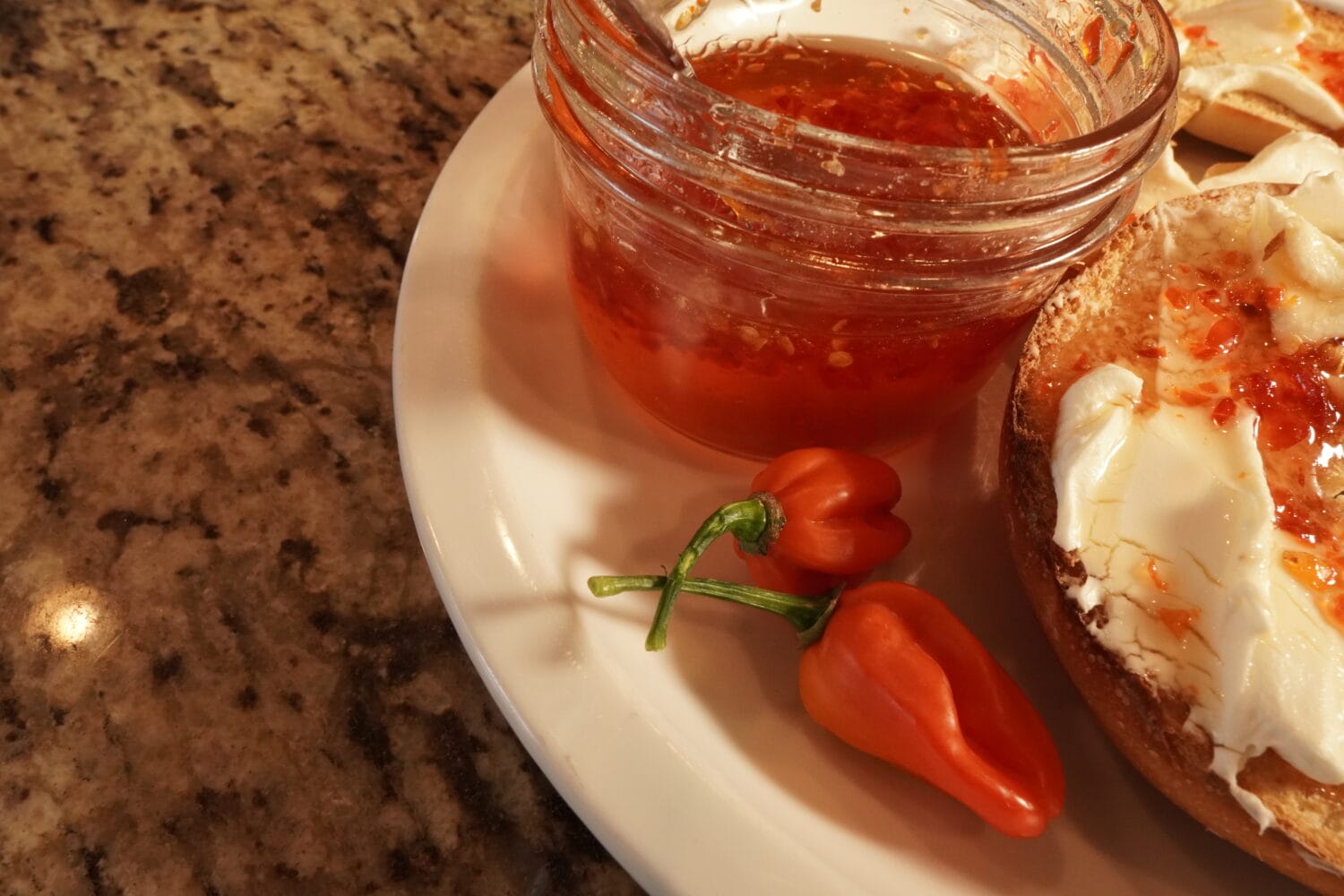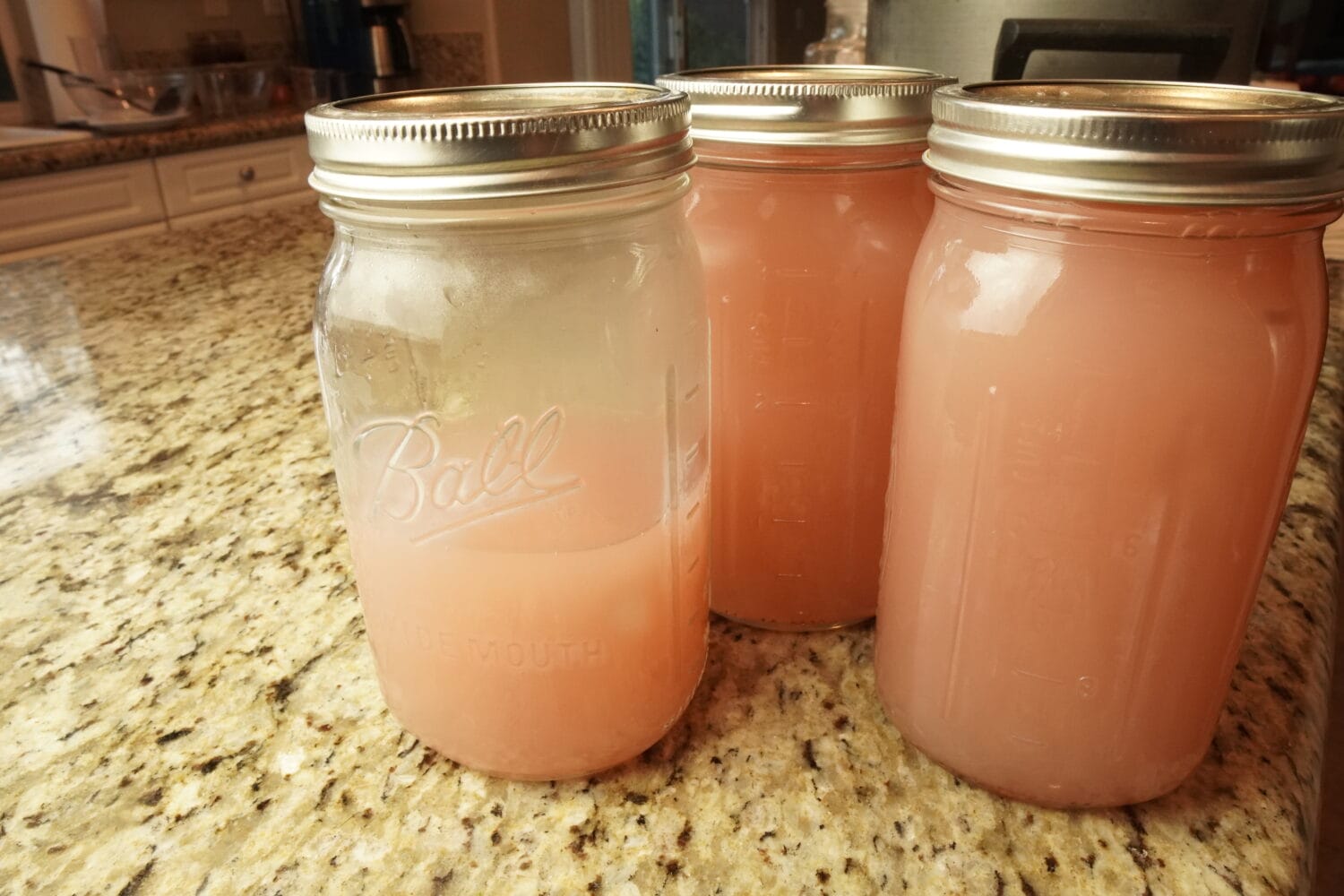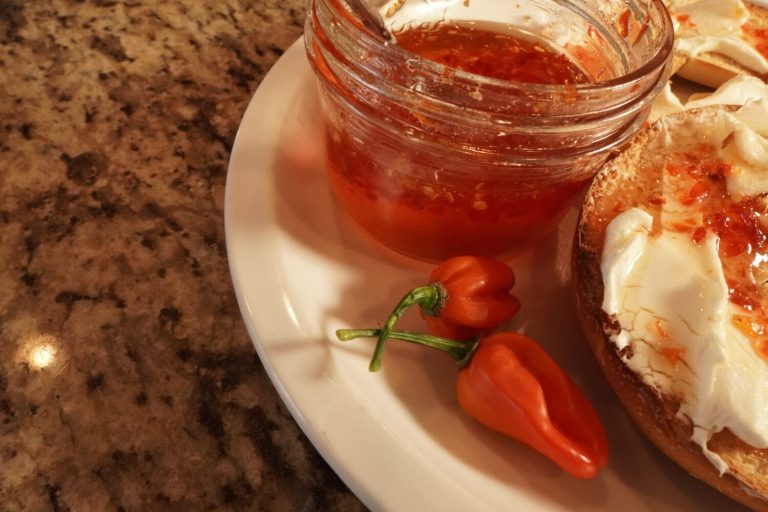
In this post, we will explore the process of crafting a Sweet Habanero Jelly. We’ll delve into the nuances of water bathing techniques for that perfect, shelf-stable finish. But be sure to stick around until the end as we’ll explain how to create your own homemade pectin as well. Our goal with these videos is never to waste a harvest, an abundance of fruit, or food scrap. We’ll equip you with essential skills for situations where a trip to the store isn’t an option.
SWEET HABANERO JELLY
I like this jelly because I use a sweet habanero variety. It has a little heat but nothing compared to a regular habanero. Your tastebuds initially react to the habanero, but then the intense heat doesn’t really happen. The sweet and hot make an excellent glaze for barbecued or smoked meats, tossed with wings, or simply spread over cream cheese on a bagel. You can use whatever hot pepper you like. If you keep your ratios the same, you can scale up or down the quantity produced. I ended up with 6, half-pint jelly jars, so this recipe will yield around 50 ounces of jelly.
- You will need 4 cups of sugar
- 4 ounces of chopped peppers
- 1 1/4 cup apple cider vinegar
- 1/4 cup lemon juice
- 1 teaspoon salt
- And a couple of drops of red and yellow food coloring to ensure our final color reflects the beautiful orangish red of these peppers.
- You will also need 1, 2-ounce box of Fruit Pectin. Later in this video, I will show you how to make pectin from scratch.
- You will also need some 4-ounce jelly jars and a pot with a lid to water bath can the finished product. That will make it shelf-stable.

- Begin by destemming your peppers. You may want to wear gloves for this process. The heat of hot peppers is mainly in the pith, that whitish part inside, and the stems. You can reduce the final heat by removing the interior of the peppers. You don’t have to get it all out, but take out as much as possible, especially the seeds, to create a more appealing final product. I also have one Thai pepper in here to get my heat level where I want it to be.
- Once the peppers are destemmed, you must mince them finely. You must be careful with this process because the oils will burn you. Some people use a blender for this process, but I don’t suggest it because it’s hard to get the oils out of some blenders after use. Take your time, consider wearing eye protection, and don’t touch anything until you thoroughly wash your hands. Keep reducing them until they are like a relish.

Tips:
Be careful washing your equipment as this can release the volatile oils into the air as steam or water vapor.
Wash your hands with dish soap while holding a stainless steel spoon. This will help to neutralize oils.
Sidenote: washing your hands with a spoon will also rid them of onion or garlic smells.
- Add peppers, sugar, vinegar, lemon juice, and salt to a small pot and slowly bring to a boil with continuous stirring to combine all ingredients.
- When all ingredients have blended together just under a boil, I add 2 drops of red coloring and 3 drops of yellow to get the color I want in my final product.
- Turn down the heat and add your pectin packet, stirring until it is fully dissolved, then turn the heat back up and bring the mix to a boil.
- Boil for 1 minute, stirring constantly, then turn off the burner.
- Let the mix cool a bit, then pour into jars warmed in hot water.
- Apply lids, then rings to finger tight and place in pot. If you have a rack you can place in your pot to keep them off the hotter surface of the pot’s bottom, it is safer.
- Once jars are filled, place them in the water bath pot and cover them with water. Apply medium heat with the lid on. Increase heat gradually for 5 mins, then bring to a boil for another 5 mins. Turn off the heat and let sit for 10 minutes to finish the water bath canning.
- Carefully remove them to the countertop once cooled. Place on dish towel if still hot.
They will seal as they cool when the dimple on top goes down. Once sealed, these are shelf-stable when stored in a cool, dark place for up to a year or even longer. Refrigerate after opening.

MAKING PECTIN
Let’s say you can’t just go to the store and pick up a package of pre-processed pectin. Our ancestors made jelly before the manufactured process, and they did so by creating their own pectin. Making homemade pectin from apple cores and skins is a great way to utilize parts of the fruit that are often discarded. Pectin is a soluble fiber (polysaccharide) found in fruits. It is used as a thickener in cooking and baking. Apples and citrus fruits are highest in pectin, so we will use apples here. The meat and some of the remnants of our pectin-making process will be used to make apple butter in the next recipe.

Here’s a simple recipe for making apple pectin:
Ingredients:
- Cores and skins from a dozen or more apples
- 4-6 cups water
- Cheesecloth, or cloth for straining
Here’s a simple recipe for making apple pectin:
Ingredients:
- Cores and skins from a dozen or more apples
- 4-6 cups water
- Cheesecloth, or cloth for straining
Instructions:
- Gather the cores and skins from about a dozen apples. These can be leftovers from making applesauce, apple pie, or other apple-based recipes.
- Place the apple cores and skins in a large pot.
- Add water to cover 1 inch above the apples.
- Bring the water and apple scraps to a boil. Once it reaches a boil, reduce the heat to low to maintain a gentle simmer to reduce the mix.
- Allow the mix to simmer and evaporate for 2 to 4 hours.
To test your pectin, put 1 teaspoon of the pectin liquid into 1 tablespoon of Isopropyl alcohol or grain spirit. It should form into a jelly. Do not skip this test or you may need to re-simmer and evaporate more water from the mix until you get it right.
When your pectin passes the test, set up a fine mesh strainer or cheesecloth over a large bowl or another pot. Strain the liquid from the cooked apple scraps.

Let the liquid cool to room temperature. This liquid contains natural pectin extracted from the apple scraps. Once cooled, store it in a clean, airtight container in the refrigerator. Use this homemade apple pectin as a natural thickening agent for homemade jams and jellies. Add it to your fruit mixture when cooking your jam or jelly according to your recipe. Remember that the potency of homemade pectin may vary, so you might need to experiment with quantities when using it in recipes. The baseline you are working with is ¼ to ½ cup of homemade apple pectin per cup of fruit for jams or a cup of fruit juice for jellies. I tend to use more rather than less. The more tart your apples were to begin with, the more pectin will likely be in your mix, so crab apples are ideal for this purpose. Additionally, since this pectin doesn’t contain preservatives, it’s advisable to use it within a few weeks or freeze it for longer storage. You could water bath this, as we learned in the previous process, and store it for a few months and up to a year, but it’s such a small quantity we make each time that it’s best just to put it in a jar and keep it in your refrigerator.
In the next post in this series, we will make the best-tasting and simplest Apple Butter you may have ever had right from my family’s recipe book. I’ll show you how to use that homemade pectin to turn regular fruit juice into a delicious jelly.
As always, stay safe out there.






